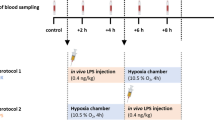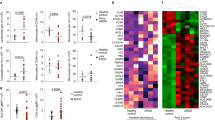Abstract
The hypoxic preconditioning of mammalian cells has been shown to have beneficial effects against hypoxic injuries. However, very little information is available on the comparative analysis of immunological responses to hypoxic and hypoxia mimetic exposure. Therefore, in the present study, mouse peritoneal macrophages and splenocytes were subjected to hypoxia exposure (0.5 % O2) and hypoxia mimetic Cobalt chloride (CoCl2) treatment to evaluate their effect on immune response and delineate the underlying signaling mechanisms. The results obtained indicated that super oxide generation increased while TLR4 expression and cell surface markers like CD25, CD40 and CD69 were suppressed in both the treatments as compared to normoxia. Cobalt chloride treatment increased NF-κB expression, nitric oxide (NO) and iNOS expression, cytokines TNF-α and IL-6 as compared to hypoxia exposure. Our study showed that CoCl2 stabilizes HIF-1α to create hypoxia like conditions but it mainly influences the inflammatory response via NF-κB signaling pathway by skewing the production of proinflammatory molecules like TNF-α, IL-6 and NO.






Similar content being viewed by others
References
Angele MK, Schwacha MG, Smail N, Catania RA, Ayala A, Cioffi WG, Chaudry IH (1999) Hypoxemia in the absence of blood loss upregulates iNOS expression and activity in macrophages. Am J Physiol 276:C285–C290
Barton BE (1997) IL-6: insights into novel biological activities. Clin Immunol Immunopathol 85(1):16–20
Bass DA, Parce JW, Dechatelet LR, Szejda P, Seeds MC, Thomas M (1983) Flow cytometric studies of oxidative product formation by neutrophils: a graded response to membrane stimulation. J Immunol 130(4):1910–1917
Bergeron M, Gidday JM, Yu AY, Semenza GL, Ferriero DM, Sharp FR (2000) Role of hypoxia-inducible factor-1 in hypoxia-induced ischemic tolerance in neonatal rat brain. Ann Neurol 48(3):285–296. doi:10.1002/1531-8249(200009)48
Bollinger T, Gies S, Naujoks J, Feldhoff L, Bollinger A, Solbach W, Rupp J (2014) HIF-1α- and hypoxia-dependent immune responses in human CD4+CD25high T cells and T helper 17 cells. J Leukoc Biol [Epub ahead of print]. doi:10.1189/jlb.3A0813-426RR
Bonello S, Zähringer C, BelAiba RS, Djordjevic T, Hess J, Michiels C, Kietzmann T, Görlach A (2007) Reactive oxygen species activate the hif-1{alpha} promoter via a functional nf{kappa}b site. Arterioscler Thromb Vasc Biol 27:755–761. doi:10.1161/01.ATV.0000258979.92828.bc
Borcar A, Menze MA, Toner M, Hand SC (2013) Metabolic preconditioning of mammalian cells: mimetic agents for hypoxia lack fidelity in promoting Phosphorylation of pyruvate dehydrogenase. Cell Tissue Res 351:99–106. doi:10.1007/s00441-012-1517-2
Brisseau GF, Grinstein S, Hackam DJ, Nordstro¨m T, Manolsoni MF, Khine AA, Rotstein OD (1996) Interleukin-1 increases vacuolar-type h1-atpase activity in murine peritoneal macrophages. J Biol Chem 271:2005–2011. doi:10.1074/jbc.271.4.2005
Chandel NS, Maltepe E, Goldwasser E, Mathieu CE, Simon MC, Schumacker PT (1998) Mitochondrial reactive oxygen species trigger hypoxia- induced transcription. Proc Natl Acad Sci USA 95(20):11715–11720. doi:10.1073/pnas.95.20.11715
Chandel NS, McClintock DS, Feliciano CE, Wood TM, Melendez JA, Rodriguez AM, Schumacker PT (2000) Reactive oxygen species generated at mitochondrial complex III stabilize hypoxia-inducible factor-1alpha during hypoxia: a mechanism of O2 sensing. J Biol Chem 275:25130–25138. doi:10.1074/jbc.M001914200
Choi SJ, Shin IJ, Je KH, Min EK, Kim EJ, Kim HS, Choe S, Kim DE, Lee DK (2013) Hypoxia antagonizes glucose deprivation on interleukin 6 expression in an Akt dependent, but HIF-1/2α independent manner. PLoS One 8(3):e58662. doi:10.1371/journal.pone.0058662
Culver C, Sundqvist A, Mudie S, Melvin A, Xirodimas D, Rocha S (2010) Mechanism of hypoxia-induced NF-kappaB. Mol Cell Biol 30(20):4901–4921. doi:10.1128/MCB.00409-10
Daniliuc S, Bitterman H, Rahat MA, Kinarty A, Rosenzweig D, Nitza L (2003) Hypoxia inactivates inducible nitric oxide synthase in mouse macrophages by disrupting its interaction with α-actinin 4. J Immunol 171(6):3225–3232. doi:10.4049/jimmunol.171.6.3225
Dawson TL, Gores GJ, Nieminen A-L, Herman B, Lemasters JJ (1993) Mitochondria as a source of reactive oxygen species during reductive stress in rat hepatocytes. Am J Physiol 264:C961
Epstein AC, Gleadle JM, McNeill LA, Dhanda A, Tian YM, Masson N, Hamilton DL, Jaakkola P, Basrtead R, Hodgkin J, Maxwell PH, Pugh CW, Schoofield PJ, Ratcliffe PJ (2001) C. Elegans egl-9 and mammalian homologs define a family of dioxygenases that regulate hif by prolyl hydroxylation. Cell 107(1):43–54. doi:10.1016/S0092-8674(01)00507-4
Fukuda R, Zhang H, Kim J, Shimoda L, Dang CV, Semenza GL (2007) HIF-1 regulates cytochrome oxidase subunits to optimize efficiency of respiration in hypoxic cells. Cell 129(1):111–122. doi:10.1016/j.cell.2007.01.047
Gidday JM (2006) Cerebral preconditioning and ischaemic tolerance. Nat Rev Neurosci 7:437–448. doi:10.1038/nrn1927
Goldberg MA, Dunning SP, Bunn HF (1988) Regulation of the erythropoietin gene: evidence that the oxygen sensor is a heme protein. Science 242(4884):1412–1415. doi:10.1126/science.2849206
Green LC, Wagner DA, Glogowski J, Skipper PL, Wishnok JS, Tannenbaum SR (1982) Analysis of nitrate, nitrite, and [15N] nitrate in biological samples. Anal Biochem 126(1):131–138. doi:10.1016/0003-2697(82)90118-X
Griess P (1879) Bemerkungen zu der abhandlung der H.H. Weselsky und Benedikt “Ueber einige azoverbindungen”. Chem Ber 12:426
Grilli A, De Lutiis MA, Patruno A, Speranza L, Cataldi A, Centurione L, Taccardi AA, Di Napoli P, De Caterina R, Barbacane R, Conti P, Felaco M (2003) Effect of chronic hypoxia on inducible nitric oxide synthase expression in rat myocardial tissue. Exp Biol Med 228(8):935–942
Hempel SL, Monick MM, Hunninghake GW (1996) Effect of hypoxia on release of IL-1 and TNF by human alveolar macrophages. Am J Respir Cell Mol Biol 14(2):170–176. doi:10.1165/ajrcmb.14.2.8630267
Ishida I, Kubo H, Suzuki S, Suzuki T, Akashi S, Inoue K, Maeda S, Kikuchi H, Sasaki H, Kondo T (2002) Hypoxia diminishes toll-like receptor 4 expression through reactive oxygen species generated by mitochondria in endothelial cells. J Immunol 169(4):2069–2075. doi:10.4049/jimmunol.169.4.2069
Kerendi F, Kirshbom PM, Halkos ME, Wang NP, Kin H, Jiang R, Zhao ZQ, Kanter KR, Guyton RA, Vinten-Johansen J (2006) Cobalt chloride pretreatment attenuates myocardial apoptosis after hypothermic circulatory arrest. Ann Thorac Surg 81(6):2055–2062. doi:10.1016/j.athoracsur.2006.01.059
Kotake-Nara E, Takizawa S, Quan J, Wang H, Saida K (2005) Cobalt chloride induces neurite outgrowth in rat pheochromocytoma PC-12 cells through regulation of endothelin-2/vasoactive intestinal contractor. J Neurosci Res 81(4):563–571. doi:10.1002/jnr.20568
Laemmli UK (1970) Cleavage of structural proteins during the assembly of the head of bacteriophage T4. Nature 227:680–685
Lahiri S (2000) Historical perspectives of cellular oxygen sensing and responses to hypoxia. J Appl Physiol 88:1467
Lan A, Xu W, Zhang H, Hua X, Zheng D, Guo R, Shen N, Hu F, Feng J, Liu D (2013) Inhibition of ROS-activated p38MAPK pathway is involved in the protective effect of H2S against chemical hypoxia-induced inflammation in PC12 cells. Neurochem Res 38(7):1454–1466. doi:10.1007/s11064-013-1044-x
Libert C, Takahashi N, Cauwels A, Brouckaert P, Bluethmann H, Fiers W (1994) Response of interleukin-6-deficient mice to tumor necrosis factor-induced metabolic changes and lethality. Eur J Immunol 24(9):2237–2242. doi:10.1002/eji.1830240945
Miller BA, Perez RS, Shah AR, Gonzales ER, Park TS, Gidday JM (2001) Cerebral protection by hypoxic preconditioning in a murine model of focal ischemia-reperfusion. Neuroreport 12(8):1663–1669
Mosmann T (1983) Rapid colorimetric assay for cellular growth and survival: application to proliferation and cytotoxicity assays. J Immunol Methods 65(1–2):55–63. doi:10.1016/0022-1759(83)90303-4
Nizet V, Johnson RS (2009) Interdependence of hypoxic and innate immune responses. Nat Rev Immunol 9:609–617. doi:10.1038/nri2607
Ratan RR, Siddiq A, Smirnova N, Karpisheva K, Haskew-Layton R, McConoughey R, Langley B, Estevez A, Huerta PT, Volpe B, Roy S, Sen CK, Gazaryan I, Cho S, Fink M, LaManna J (2007) Harnessing hypoxic adaptation to prevent, treat, and repair stroke. J Mol Med 85(12):1331–1338. doi:10.1007/s00109-007-0283-1
Schroedl C, McClintock DS, Budinger GR, Chandel NS (2002) Hypoxic but not anoxic stabilization of HIF-1 alpha requires mitochondrial reactive oxygen species. Am J Physiol Lung Cell Mol Physiol 283:L922–L931. doi:10.1152/ajplung.00014.2002
Semenza GL, Roth PH, Fang HM, Wang GL (1994) Transcriptional regulation of genes encoding glycolytic enzymes by hypoxia-inducible factor 1. J Biol Chem 269:23757–23763
Shimoda LA, Fallon M, Pisarcik S, Wang J, Semenza GL (2006) HIF-1 regulates hypoxic induction of NHE1 expression and alkalinization of intracellular pH in pulmonary arterial myocytes. Am J Physiol Lung Cell Mol Physiol 291:L941–L949. doi:10.1152/ajplung.00528.2005
Shrivastava K, Sairam M, Bansal A, Singh SS, Ilavazhagan G (2008a) Cobalt supplementation promotes hypoxic tolerance and facilitates acclimatization to hypoxia in rat brain. High Alt Med Biol 9(1):63–75. doi:10.1089/ham.2008.1046
Shrivastava K, Shukla D, Bansal A, Ganju L, Sairam M (2008b) Cobalt chloride attenuates hypobaric hypoxia induced vascular leakage in rat brain: molecular mechanisms of action of cobalt chloride. Toxicol Appl Pharmacol 231(5):354–363. doi:10.1016/j.etp.2009.06.012
Shrivastava K, Shukla D, Bansal A, Sairam M, Banerjee PK, Ilavazhagan G (2008c) Neuroprotective effect of cobalt chloride on hypobaric hypoxia-induced oxidative stress. Neurochem Int 52(3):368–375. doi:10.1016/j.neuint.2007.07.005
Smith PK, Krohn RI, Hermanson GT, Mallia AK, Gartner FH, Provenzano MD, Fujimoto EK, Goeke NM, Olson BJ, Klenk DC (1985) Measurement of protein using bicinchoninic acid. Anal Biochem 150(1):76–85. doi:10.1016/0003-2697(85)90442-7
Sorond FA, Ratan RR (2000) Ironing-out mechanisms of neuronal injury under hypoxic-ischemic conditions and potential role of iron chelators as neuroprotective agents. Antioxid Redox Signal 2(3):421–436. doi:10.1089/15230860050192206
Stenger C, Naves T, Verdier M, Ratinaud MH (2011) The cell death response to the ROS inducer, cobalt chloride, in neuroblastoma cell lines according to p53 status. Int J Oncol 39:601–609. doi:10.3892/ijo.2011.1083
Towbin H, Staehelin T, Gordon J (1979) Electrophoretic transfer of proteins from polyacrylamide gels to nitrocellulose sheets: procedure and some applications. Proc Natl Acad Sci USA 76(9):4350–4354
Xi L, Taher M, Yin C, Salloum F, Kukreja RC (2004) Cobalt chloride induces delayed cardiac preconditioning in mice through selective activation of HIF-1alpha and AP-1 and iNOS signaling. Am J Physiol Heart Circ Physiol 287(6):H2369–H2375. doi:10.1152/ajpheart.00422.2004
Xing Z, Gauldie J, Cox G, Baumann H, Jordana M, Lei X, Achong MK (1998) Il-6 is an antiinflammatory cytokine required for controlling local or systemic acute inflammatory responses. J Clin Investig 101(2):311–320. doi:10.1172/JCI1368
Yao SY, Soutto M, Sriram S (2008) Preconditioning with cobalt chloride or desferrioxamine protects oligodendrocyte cell line (MO3.13) from tumor necrosis factor-alpha-mediated cell death. J Neurosci Res 86(11):2403–2413. doi:10.1002/jnr.21697
Yuan Y, Hilliard G, Ferguson T, Millhorn DE (2003) Cobalt inhibits the interaction between hypoxia-inducible factor-α and von hippel-lindau protein by direct binding to hypoxia-inducible factor-α. J Biol Chem 278:15911–15916. doi:10.1074/jbc.M300463200
Zaman K, Ryu H, Hall D (1999) Protection from oxidative stress-induced apoptosis in cortical neuronal cultures by iron chelators is associated with enhanced DNA binding of hypoxia inducible factor-1 and ATF-1/CREB and increased expression of glycolytic enzymes, p21(waf1/cip1), and erythropoietin. J Neuro Sci 19(22):9821–9830
Zou W, Yan M, Xu W, Huo H, Sun L, Zheng Z, Liu X (2001) Cobalt chloride induces PC12 cells apoptosis through reactive oxygen species and accompanied by AP-1 activation. J Neurosci Res 64(6):646–653. doi:10.1002/jnr.1118
Acknowledgments
This work was supported by a Grant from the Defence Research and Development Organization (DRDO), Ministry of Defence, Government of India. Shweta thanks DRDO for financial assistance in the form of Senior Research Fellowship.
Conflict of interest
The authors declare no conflict of interest.
Author information
Authors and Affiliations
Corresponding author
Rights and permissions
About this article
Cite this article
Shweta, Mishra, K.P., Chanda, S. et al. A comparative immunological analysis of CoCl2 treated cells with in vitro hypoxic exposure. Biometals 28, 175–185 (2015). https://doi.org/10.1007/s10534-014-9813-9
Received:
Accepted:
Published:
Issue Date:
DOI: https://doi.org/10.1007/s10534-014-9813-9




